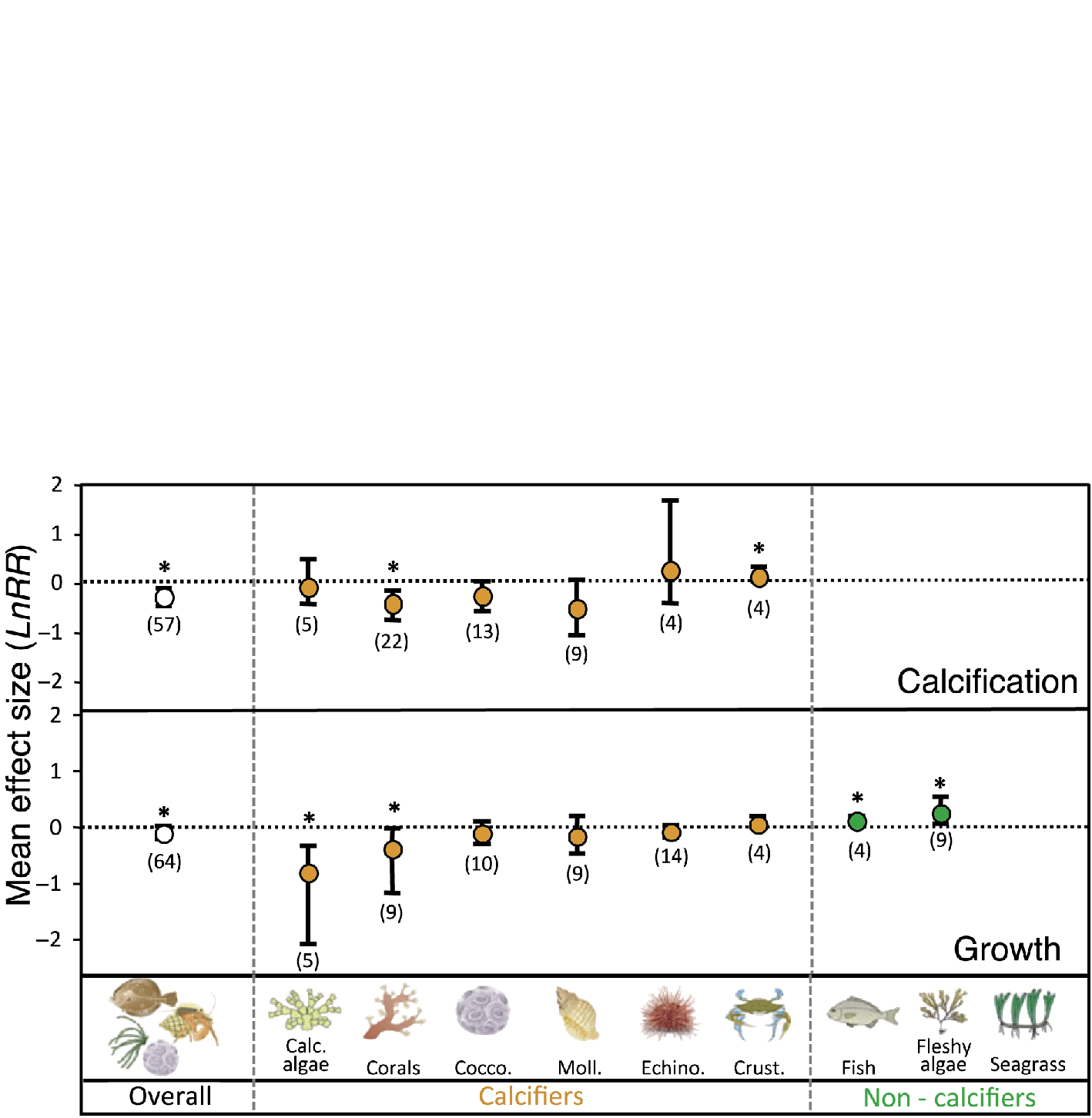- Home
- Publications
- PAGES Magazine
- Ocean Acidification - How Will Ongoing Ocean Acidification Affect Marine Life? [Present]
Ocean Acidification - How will ongoing ocean acidification affect marine life? [Present]
Jean-Pierre Gattuso
PAGES news
20(1)
36
2012
Jean-Pierre Gattuso
CNRS and Université Pierre et Marie Curie, Villefranche-sur-Mer, France; gattuso obs-vlfr.fr
obs-vlfr.fr
Ocean acidification, an expression coined in the early 2000s, describes changes in the chemistry of seawater generated by the uptake of anthropogenic carbon dioxide (CO2). Among those changes is an increase in the concentration of dissolved inorganic carbon as well as a decrease in pH and the saturation state of calcium carbonate (Ω). Evidence for ocean acidification and its consequences for marine organisms and ecosystems have only recently begun to be investigated (Gattuso and Hansson 2011).
Some aspects of ocean acidification, such as the changes in the carbonate chemistry, are known with a high degree of certainty. It is also well established that three areas of the global ocean are more susceptible to ocean acidification than others, either because ocean acidification will be more severe (e.g. polar regions and the deep sea) or because it acts synergistically with another major stressor (e.g. coral reefs which are also strongly affected by global warming). Most biological, ecological and biogeochemical effects are much less certain. Calcification, primary production, nitrogen fixation and biodiversity will all be affected, but the magnitude of the projected changes remains unclear.
Although some studies indicate no effect or a positive effect of ocean acidification on the rate of calcification of some organisms (Andersson et al. 2011; Riebesell et al. 2011), meta-analyses reveal an overall significant, negative effect (e.g. Hendriks et al. 2010; Kroeker et al. 2010). In general, corals experience particularly adverse effects, whereas crustaceans, for example, grow thicker shells. Whether or not calcification decreases in response to elevated CO2 and lower Ω, the deposition of calcium carbonate is thermodynamically less favorable under such conditions. Some organisms could up-regulate their metabolism and calcification to compensate for lower Ω, but this would have energetic costs that would divert energy from other essential processes, and thus may not be sustainable in the long term. Full or partial compensation may be possible in certain organisms if the additional energy demand required to calcify under elevated CO2 can be supplied. We need to know much more about the molecular and physiological processes involved in calcifying marine organisms to better understand the response of calcification to ocean acidification.
Ocean acidification is expected to affect not only single organisms but whole populations and thus ecosystems. There is mounting evidence, especially for benthic communities, suggesting that their composition will change as the oceans acidify. For example, the structure of an ecosystem around submarine CO2 vents in the Mediterranean Sea appears to be governed by the concentration gradient around the vents (Barry et al. 2011). Non-calcareous algae replace calcareous ones closer to the vents, and no juvenile calcifiers are found close to the vents.
We know considerably less about the effects on composition of pelagic communities. Experiments on natural phytoplankton assemblages consistently show a modest increase in carbon fixation at elevated pCO2 (Riebesell and Tortell 2011). The increased CO2 levels would aid the growth of some groups of phytoplankton such as cyanobacteria, and decrease the competitiveness of others (e.g. some calcifiers). The combined effects of acidification and other global changes on ecosystems are uncertain but deserve more scrutiny, especially because of potential economic consequences on, for example, the fishing and tourism industry.
Ocean acidification and its impacts on marine ecosystems could provide an additional reason for reducing CO2 emissions, but we need to reduce the uncertainties and offer a prognosis despite the sometimes conflicting observations. Synthetic studies will be key to make sense of the many dimensions of ocean acidification and its interactions with other stressors such as warming, coastal eutrophication and deoxygenation. There is reason to be optimistic, at least on the research front: the coming years will witness the launch of major research initiatives, in addition to IPCC and other assessments, which are expected to considerably improve our level of understanding.
selected references
Full reference list online under: http://pastglobalchanges.org/products/newsletters/ref2012_1.pdf
Gattuso J-P et al. (2011) Ocean acidification: knowns, unknowns and perspectives. In: Gattuso J-P and Hansson L (Eds) Ocean acidification, Oxford University Press, 291-312
Gattuso J-P and Hansson L (2011) Ocean acidification: background and history. In: Gattuso J-P and Hansson L (Eds) Ocean acidification, Oxford University Press, 1-20
Hendriks IE, Duarte CM and Alvarez M (2010) >Estuarine, Coastal and Shelf Science 86:157-164
Kroeker K, Kordas RL, Crim RN and Singh GG (2010) Ecology Letters 13: 1419-1434
Riebesell U and Tortell PD (2011) Effects of ocean acidification on pelagic organisms and ecosystems. In: Gattuso J-P and Hansson L (Eds) Ocean acidification, Oxford University Press, 99-121
